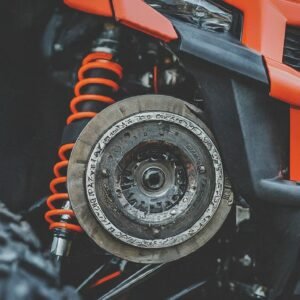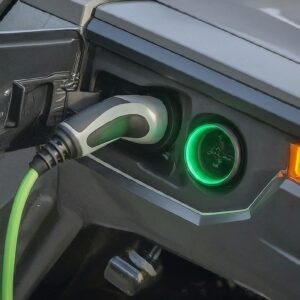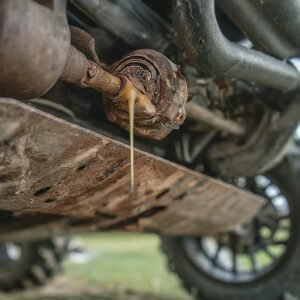The Honda Pioneer 500 is a popular side-by-side vehicle known for its durability and versatility. However, like any machine, it can encounter problems from time to time. In this article, we will discuss 11 major Honda Pioneer 500 problems and provide solutions to help you address them.
Honda Pioneer 500 Problems and Solutions
The most common issues of the Honda Pioneer 500 are engine overheating, starting problems, battery issues, tire issues, clutch issues, and transmission problems. Now we discuss them one by one.
1. Starting problems

If you’re encountering starting problems with your Honda Pioneer 500, it can be frustrating, but there are steps you can take to troubleshoot and resolve the issue.
- Check the Battery: A weak or dead battery is a common cause of starting issues in your UTV. Start by inspecting the battery terminals for corrosion and make sure that they are securely connected. If the battery is old or depleted, consider replacing it with a new one.
- Check the Spark Plug: A faulty spark plug can prevent the engine from starting. Ensure that the spark plug is in good condition by removing it and inspecting it. If necessary, replace the spark plug with a new one and ensure it is properly gapped.
- Verify Fuel Flow: Check the fuel level in the tank of your Honda Pioneer and verify that the fuel valve is open. In the case of old or contaminated fuel, drain and refuel the tank. Additionally, check the fuel filter for any clogs or debris that may be restricting fuel flow.
- Test the Ignition System: Make sure that the ignition switch is in the “on” position and that the kill switch, if equipped, is not engaged. Test the ignition system by turning the key and listening for the sound of the starter motor engaging. If you hear a clicking sound or nothing at all, it may indicate a problem with the starter motor or ignition system.
- Inspect the Starter Motor: If the engine fails to crank when the ignition is turned, the starter motor may be faulty. Make sure the connections to the starter motor are tight and corrosion-free. If the connections are secure and the motor still fails to engage, it may need to be replaced.
- Check for Engine Compression: Low or uneven compression can prevent the engine from starting. Check each cylinder’s compression levels with a compression tester. If the compression is below the manufacturer’s specifications, it may indicate a problem with the piston rings, valves, or cylinder head gasket.
- Consult the Owner’s Manual: If you’re unable to diagnose the problem or resolve the starting issue on your own, refer to the owner’s manual for troubleshooting tips specific to your Honda Pioneer 500 model. Additionally, consider seeking assistance from a certified Honda technician for further diagnosis and repair.
2. Honda Pioneer 500 Transmission problems
These are also the major issues that its owners face. Here are some problems of transmission with the solutions.
- Slipping Gears: If you notice that your Pioneer 500 is slipping out of gear or struggling to engage gears properly, it could indicate a problem with the transmission fluid level or quality. Check the transmission fluid level and condition, and top it up or replace it if necessary according to the manufacturer’s recommendations.
- Difficulty Shifting: Difficulty shifting gears, such as gears grinding or sticking, can be caused by several factors, including worn clutch components or improper adjustment. Inspect the clutch system for any signs of wear or damage, and adjust or replace components as needed to ensure smooth shifting.
- Transmission Noise: Unusual noises coming from the transmission, such as whining, grinding, or clunking, may indicate worn or damaged internal components. Have the transmission inspected by a qualified mechanic to diagnose the issue accurately and determine the necessary repairs.
- Fluid Leaks: Transmission fluid leaks can lead to a loss of fluid pressure and cause various transmission problems, including slipping gears and overheating. Check for any signs of fluid leaks around the transmission housing or lines, and repair any leaks promptly to prevent further damage.
- Overheating: Overheating can occur if the transmission fluid is not properly cooled, leading to reduced transmission efficiency and potential damage to internal components. Ensure that the transmission cooling system is functioning correctly and that the fluid is clean and at the correct level.
- Electronic Control Module (ECM) Issues: In some cases, transmission problems may be caused by issues with the electronic control module (ECM), which controls the operation of the transmission. Have the ECM scanned for any error codes, and address any identified issues accordingly.
Also explore the Landmaster UTV Problems
3. Shifting problems
Here are some shifting issues of the Honda Pioneer.
- Difficulty Shifting Gears: If you’re having trouble shifting gears, it could be due to issues with the transmission or clutch. Start by checking the transmission fluid level to ensure it’s at the correct level. Low fluid levels can cause shifting problems. If the fluid level is fine, inspect the clutch system for any signs of wear or damage, such as worn clutch plates or a stretched clutch cable. Replace any worn components as needed to restore proper shifting.
- Grinding or Clunking Noise: Unusual noises like grinding or clunking when shifting gears could indicate problems with the transmission or drivetrain. Check the transmission oil for any signs of contamination or metal shavings, as these can indicate internal damage. If you notice any issues, have the transmission inspected by a qualified mechanic to diagnose and repair the problem.
- Stuck in Gear: If your Pioneer 500 gets stuck in gear and won’t shift, it could be due to a variety of issues. Start by checking for any obstructions or debris around the shift linkage or transmission housing that may be preventing the gears from engaging properly. If everything looks clear, the problem may be internal to the transmission or shift mechanism. It’s best to have a professional mechanic inspect and repair the problem in this case.
- Hard Shifting: If shifting feels stiff or requires excessive force, it could be due to issues with the clutch cable or linkage. Inspect the clutch cable for any signs of fraying or stretching, and adjust or replace it as needed. Lubricate the shift linkage and pivot points to ensure smooth operation. Additionally, check the transmission for any signs of wear or damage that may be causing increased resistance when shifting.
- Slipping Gears: If the transmission slips out of gear while driving, it could be due to worn or damaged gears, shift forks, or synchros. Have the transmission inspected by a professional mechanic to diagnose the problem and replace any worn or damaged components?
4. Loss of Power
If you’re experiencing loss of power issues with your Honda Pioneer 500, it’s essential to address them promptly to ensure the safety and performance of your vehicle. Here’s a detailed explanation of common causes and helpful tips to resolve them:
- Fuel System Problems: One common reason for the loss of power in the Honda Pioneer 500 is issues with the fuel system. Check the fuel filter for clogs or blockages, as these can restrict fuel flow and result in decreased power. Additionally, inspect the fuel lines for leaks or damage, as any air leaks can disrupt the fuel delivery to the engine.
- Air Filter Blockage: A dirty or clogged air filter can also lead to loss of power. Make sure to regularly inspect and clean or replace the air filter as needed to maintain proper airflow to the engine. A clean air filter ensures optimal performance and prevents engine strain.
- Spark Plug Problems: Faulty or worn-out spark plugs can cause misfires and result in a loss of power. Check the spark plugs for signs of wear or damage, such as fouling or corrosion, and replace them if necessary. Properly gapped and functioning spark plugs are crucial for efficient combustion and engine performance.
- Engine Overheating: Overheating can lead to power loss in the Honda Pioneer 500. Check the engine coolant levels and ensure proper circulation by inspecting the radiator and cooling system for any leaks or blockages. Regular maintenance of the cooling system helps prevent overheating and ensures consistent power output.
- Transmission Issues: Problems with the transmission, such as low transmission fluid levels or worn-out components, can cause power loss. Check the transmission fluid levels and inspect the transmission for any signs of leaks or damage. Replace worn-out transmission components as needed to restore power and ensure smooth shifting.
- Exhaust System Restrictions: A restricted or blocked exhaust system can hinder engine performance and result in power loss. Inspect the exhaust system for any obstructions, such as debris or buildup, and clear them to allow proper exhaust flow. Additionally, check for any leaks or damage in the exhaust system that may affect performance.
- Electrical Problems: Electrical issues, such as a weak battery or faulty wiring, can also contribute to loss of power. Check the battery voltage and connections to ensure proper electrical supply to the engine. Inspect the wiring harness for any signs of damage or corrosion and repair or replace it as needed.
5. Clutch Issues

Here are some of the common clutch problems and helpful tips to resolve them:
- Slipping Clutch: If you notice that the engine revs increase without a corresponding increase in vehicle speed, it could indicate a slipping clutch. This problem may be caused by worn clutch plates or improper clutch adjustment. To fix it, you may need to replace the clutch plates or adjust the clutch cable to ensure proper engagement.
- Hard Shifting: Difficulty shifting gears or a stiff clutch pedal could be signs of a clutch linkage or hydraulic system problem. Check the clutch cable or hydraulic fluid levels to ensure they are within the recommended range. If necessary, adjust the clutch linkage or bleed the hydraulic system to improve shifting performance.
- Clutch Drag: Clutch drag occurs when the clutch does not fully disengage, leading to difficulty starting the engine or shifting gears. A misadjusted clutch cable, worn clutch components, or hydraulic system problems may cause this issue. Adjust the clutch cable inspect the clutch plates for wear, and replace any damaged components as needed.
- Clutch Noise: Unusual noises such as grinding or rattling when engaging or disengaging the clutch could indicate worn or damaged clutch components. Inspect the clutch plates, release bearing, and clutch basket for signs of wear or damage, and replace any worn or damaged parts to eliminate the noise.
- Clutch Overheating: Continuous use of the clutch, especially in challenging terrain or heavy-duty applications, can lead to clutch overheating. Overheating can cause clutch slippage, reduced performance, and premature wear. To prevent clutch overheating, avoid excessive clutch use and allow the clutch to cool down between heavy-duty applications.
- Clutch Cable Fraying or Damage: Inspect the clutch cable regularly for signs of fraying, kinking, or damage. A damaged clutch cable can lead to poor clutch engagement and shifting issues. Replace the clutch cable if any signs of damage are detected to ensure reliable clutch operation.
6. Battery Issues

If you’re encountering battery issues with your Honda Pioneer 500, it’s essential to address them promptly to ensure your vehicle’s reliability and performance. Here’s a breakdown of common battery problems and some helpful tips to resolve them:
- Battery Drain: If you notice that your Honda Pioneer 500’s battery is constantly draining, it could be due to several factors. One common cause is leaving accessories or lights on when the engine is off, draining the battery over time. To prevent this, make sure to turn off all accessories and lights when you’re not using them. Additionally, faulty wiring or a malfunctioning component could be drawing power from the battery even when the vehicle is turned off. Inspect the wiring and electrical system for any signs of damage or wear and replace any damaged components as needed.
- Weak Battery: A weak or undercharged battery can result in difficulty starting your Honda Pioneer 500, especially in cold weather conditions. To address this issue, consider investing in a battery charger or maintainer to keep the battery fully charged when the vehicle is not in use. Regularly check the battery voltage and perform a load test to ensure it’s holding a charge properly. If the battery is old or unable to hold a charge, it may be time to replace it with a new one.
- Corrosion: Corrosion on the battery terminals can prevent proper electrical contact, leading to starting issues and poor performance. To prevent corrosion, regularly clean the battery terminals with a mixture of baking soda and water and apply a thin layer of dielectric grease to prevent future corrosion buildup. Additionally, inspect the battery cables for any signs of damage or corrosion and replace them if necessary.
- Extreme Temperatures: Extreme temperatures, both hot and cold, can affect the performance of your Honda Pioneer 500’s battery. In cold weather, the battery’s ability to produce power is reduced, making it harder to start the engine. In hot weather, high temperatures can cause the battery to overheat and degrade faster. To mitigate the effects of extreme temperatures, consider parking your vehicle in a shaded area or using a battery insulation kit to regulate temperature fluctuations.
- Improper Maintenance: Proper battery maintenance is crucial for ensuring optimal performance and longevity. Regularly check the battery fluid levels and top them up if necessary with distilled water. Inspect the battery for any signs of physical damage or leaks and replace it if needed. Additionally, following the manufacturer’s recommended maintenance schedule for your Honda Pioneer 500 can help prevent battery issues and keep your vehicle running smoothly.
7. Tire Issues
If you’re encountering tire issues with your Honda Pioneer 500, it’s essential to address them promptly for your safety and vehicle’s performance. Let’s delve into some common tire problems and helpful tips to resolve them:
- Tire Wear and Tear: Over time, your Pioneer 500’s tires may experience wear and tear due to regular use, rough terrain, or improper maintenance. Check your tires regularly for signs of wear, such as uneven tread wear, cracks, or bulges. Replace worn-out tires promptly to ensure optimal traction and handling.
- Puncture or Damage: Punctures or damage to the tire can occur from sharp objects on the trail or debris on the road. If you notice a puncture or tear in your tire, it’s essential to address it promptly to prevent further damage or a potential blowout. Consider carrying a tire repair kit or spare tire with you for emergencies.
- Underinflation or Overinflation: Improper tire inflation can lead to handling issues, decreased fuel efficiency, and premature tire wear. Check your tire pressure regularly using a tire pressure gauge and ensure they are inflated to the manufacturer’s recommended PSI (pounds per square inch). Underinflated tires can cause poor handling and increased risk of tire damage, while overinflated tires can result in a rough ride and reduced traction.
- Alignment Problems: Misalignment of the wheels can cause uneven tire wear and affect the handling and stability of your Pioneer 500. If you notice your vehicle pulling to one side or uneven tire wear, it may indicate a need for wheel alignment. Have your alignment checked by a professional mechanic and adjust as necessary to ensure proper tire wear and optimal performance.
- Weather and Terrain Conditions: Extreme weather conditions, such as heat, cold, or wet weather, can affect tire performance and durability. Additionally, rough or rocky terrain can increase the risk of tire damage or punctures. Be mindful of the weather and terrain conditions when driving your Pioneer 500 and adjust your driving style accordingly to minimize tire damage.
- Proper Maintenance: Regular maintenance of your Honda Pioneer 500, including tire inspection, rotation, and alignment, can help prevent tire issues and prolong the life of your tires. Follow the manufacturer’s recommended maintenance schedule and guidelines for tire care to ensure optimal performance and safety.
8. Differential lock problems
Here are some differential lock problems that its owner face.
- Differential Lock Not Engaging: If you’re having trouble getting the differential lock to engage, it could be due to various reasons. Start by checking if any debris or dirt is obstructing the locking mechanism. Clean the area thoroughly and try engaging the lock again. If the problem persists, there may be a mechanical issue with the differential lock mechanism that requires professional attention.
- Difficult to Disengage: On the other hand, if you find it challenging to disengage the differential lock, the issue might lie with the mechanism itself. Inspect the locking system for any signs of wear or damage. Lubricate the components if necessary to ensure smooth operation. If the problem persists, consider seeking assistance from a certified Honda technician to diagnose and repair the issue.
- Strange Noise or Grinding Sensation: If you hear unusual noises or experience a grinding sensation when engaging or disengaging the differential lock, it could indicate a more severe problem. This could be caused by worn-out components within the differential or improper alignment. Avoid using the differential lock until the issue is resolved to prevent further damage to the drivetrain.
- Electrical Malfunction: In some cases, differential lock problems may be caused by electrical issues. Check the wiring and connections associated with the differential lock system for any signs of damage or corrosion. Make sure all electrical components are properly connected and functioning. If you suspect an electrical malfunction, consult a qualified technician to diagnose and repair the issue.
- Regular Maintenance: To prevent differential lock problems, it’s essential to perform regular maintenance on your Honda Pioneer 500. This includes inspecting and lubricating the differential lock mechanism, checking fluid levels, and replacing worn-out components as needed. Following the manufacturer’s maintenance schedule can help prevent issues and prolong the lifespan of your vehicle.
9. Honda Pioneer 500 Engine Overheating Problems
Suppose you’re experiencing engine overheating problems with your Honda Pioneer 500. In that case, it’s crucial to address them promptly to prevent damage to your vehicle and ensure your safety. Here’s a detailed explanation of potential causes and helpful solutions:
- Low Coolant Level: Check the coolant reservoir to ensure it’s at the proper level. Low coolant levels can lead to inadequate cooling and engine overheating. If the coolant is low, top it up with the manufacturer-recommended coolant mixture.
- Blocked Radiator: Inspect the radiator for any debris, dirt, or insects blocking the airflow. A blocked radiator restricts airflow, leading to inefficient cooling and engine overheating. Use compressed air or a gentle stream of water to clean the radiator fins and remove any obstructions.
- Faulty Thermostat: A malfunctioning thermostat can cause the engine to overheat by either staying closed, preventing coolant flow, or staying open, allowing coolant to flow continuously. Replace the thermostat if it’s faulty to restore proper coolant flow and temperature regulation.
- Coolant Leaks: Check for any visible coolant leaks around the radiator, hoses, water pump, or engine block. Coolant leaks can lead to a loss of coolant, resulting in engine overheating. Repair any leaks and replace damaged components to prevent further coolant loss.
- Clogged Cooling System: Over time, the cooling system can become clogged with sediment, rust, or scale buildup, reducing its efficiency. Flush the cooling system to remove any deposits and restore proper coolant circulation and cooling capacity.
- Faulty Water Pump: The water pump is responsible for circulating coolant throughout the engine and cooling system. A faulty water pump can lead to insufficient coolant circulation and engine overheating. Replace the water pump if it’s defective to ensure proper coolant flow.
- Improper Airflow: Ensure that the cooling fan is functioning correctly and that nothing is obstructing its airflow. A malfunctioning cooling fan or blocked airflow can lead to inadequate cooling and engine overheating, especially at low speeds or when idling.
- Excessive Load or Stress: Avoid overloading the vehicle or towing heavy loads beyond its capacity, as this can put excessive strain on the engine and lead to overheating. Allow the engine to cool down periodically during extended periods of heavy use.
- High Ambient Temperatures: In hot weather conditions, engine overheating can occur more easily. Take precautions such as avoiding prolonged idling, using lower gears when climbing hills, and maintaining a consistent speed to reduce heat build-up.
- Regular Maintenance: Lastly, ensure that your Honda Pioneer 500 receives regular maintenance, including coolant flushes, radiator cleanings, and inspections of cooling system components. Proper maintenance helps prevent engine overheating and ensures optimal performance and longevity.
10. Fuel System Malfunction

Honda Pioneer 500 owners may experience problems with the fuel system. This can include issues such as difficulty starting the engine, poor fuel efficiency, or a sputtering engine.
- Clogged Fuel Filter: One common cause of fuel system malfunctions is a clogged fuel filter. Over time, dirt and debris can accumulate in the fuel filter, restricting fuel flow to the engine. To fix this issue, you’ll need to replace the fuel filter with a new one. Regularly replacing the fuel filter as part of your maintenance routine can help prevent future issues.
- Dirty Fuel Injectors: Dirty or clogged fuel injectors can also lead to fuel system problems in your Honda Pioneer 500. When the fuel injectors become clogged, they may not deliver the correct amount of fuel to the engine, causing it to run rough or stall. Cleaning or replacing the fuel injectors can help restore proper fuel delivery and engine performance.
- Faulty Fuel Pump: A faulty fuel pump can cause a variety of fuel system issues, including poor fuel delivery and engine hesitation. If you suspect the fuel pump is the culprit, you’ll need to inspect it for signs of damage or wear. If necessary, replace the fuel pump with a new one to restore proper fuel flow to the engine.
- Fuel Contamination: Contaminated fuel, such as water or debris, can also wreak havoc on your Honda Pioneer 500’s fuel system. Replace the fuel tank with fresh, clean fuel if you suspect fuel contamination. Additionally, consider using a fuel additive designed to remove water and contaminants from the fuel system.
- Electrical Issues: In some cases, fuel system malfunctions may be caused by electrical issues, such as a faulty fuel pump relay or a loose wiring connection. Inspect the electrical components of the fuel system, including the fuel pump relay and wiring harness, for any signs of damage or corrosion. Repair or replace any faulty components as needed to restore proper operation.
11. Suspension Trouble
The suspension system of the Honda Pioneer 500 can also encounter problems over time. This can result in a rough or bumpy ride, reduced stability, or excessive bouncing.
- Sagging Suspension: If you notice that your Pioneer 500’s suspension seems lower than usual or sags unevenly, it could indicate worn-out suspension components or improper adjustment. Check the suspension springs, shocks, and bushings for signs of wear or damage, and replace any worn parts as needed. Additionally, ensure that the suspension preload is properly adjusted to maintain the correct ride height.
- Bumpy Ride: If you’re experiencing a rough or bumpy ride, it could be due to worn-out shock absorbers or inadequate suspension tuning. Inspect the shocks for leaks, damage, or worn-out bushings, and replace them if necessary. Consider adjusting the suspension settings to optimize comfort and performance for your driving conditions.
- Bottoming Out: Bottoming out occurs when the suspension compresses fully, causing the vehicle to hit or “bottom out” against the frame or suspension components. This can lead to damage and discomfort while driving. Check the suspension preload and adjust it as needed to prevent bottoming out. Additionally, consider upgrading to stiffer springs or installing after-market suspension components for improved performance and durability.
- Excessive Body Roll: If your Pioneer 500 exhibits excessive body roll or leans excessively during cornering, it could indicate worn-out sway bar bushings or inadequate suspension tuning. Inspect the sway bar bushings for wear or damage and replace them if necessary. Consider adjusting the suspension settings or installing stiffer sway bars to reduce body roll and improve stability during cornering.
- Uneven Tire Wear: Uneven tire wear can be a sign of suspension issues such as misalignment or worn-out suspension components. Inspect the tires for signs of uneven wear patterns and adjust the suspension alignment as needed. Additionally, check the suspension components for wear or damage and replace any worn parts to prevent further tire wear.
- Noise or Clunking: If you hear unusual noises such as clunking or rattling coming from the suspension, it could indicate loose or worn-out suspension components. Inspect the suspension components for loose bolts, worn bushings, or damaged parts, and tighten or replace them as necessary. Consider upgrading to custom suspension components for improved durability and performance.
What is the top speed of the Honda Pioneer 500?
The Honda Pioneer 500 has a top speed of around 40 miles per hour (mph). This is a fairly typical top speed for a utility side-by-side, which prioritizes durability and handling over outright speed.
Conclusion:
So here we provide complete information about the most common Honda Pioneer 500 problems with their easy solutions. By being aware of these common issues and their solutions, you can ensure that your Honda Pioneer 500 continues to perform at its best.

